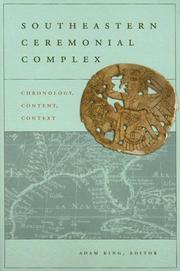| Listing 1 - 6 of 6 |
Sort by
|

ISBN: 0817381368 9780817381363 9780817315542 0817315543 9780817354091 0817354093 Year: 2007 Publisher: Tuscaloosa [Ala.] University of Alabama Press
Abstract | Keywords | Export | Availability | Bookmark
 Loading...
Loading...Choose an application
- Reference Manager
- EndNote
- RefWorks (Direct export to RefWorks)
A timely, comprehensive reevaluation of the Southeastern Ceremonial Complex. One of the most venerable concepts in Southeastern archaeology is that of the Southern Cult. The idea has its roots in the intensely productive decade (archaeologically) of the 1930's and is fundamentally tied to yet another venerable concept-Mississippian culture. The last comprehensive study of the melding of these two concepts into the term Southeastern Ceremonial Complex (SECC) is more than two decades old, yet our understanding of the objects, themes, and artistic styles associated with
Indians of North America --- Mississippian culture. --- American aborigines --- American Indians --- First Nations (North America) --- Indians of the United States --- Indigenous peoples --- Native Americans --- North American Indians --- Temple Mound culture --- Mound-builders --- Antiquities. --- Rites and ceremonies. --- Culture --- Ethnology --- Antiquities --- Southern States

ISBN: 0817382003 9780817382001 0817312234 9780817312237 0817312234 0817312242 9780817312237 9780817312244 Year: 2003 Publisher: Tuscaloosa University of Alabama Press
Abstract | Keywords | Export | Availability | Bookmark
 Loading...
Loading...Choose an application
- Reference Manager
- EndNote
- RefWorks (Direct export to RefWorks)
A Dan Josselyn Memorial Publication This is a detailed reconstruction of the waxing and waning of political fortunes among the chiefly elites at an important center of the prehistoric world. At the time the first Europeans arrived in the New World, thousands of earthen platform mounds dotted the landscape of eastern North America. Only a few of the mound sites have survived the ravages of time and the devastation of pilferers; one of these valuable monuments is Etowah, located near Cartersville in northern Georgia. Over a period of more than
Social archaeology --- Mississippian pottery --- Chiefdoms --- Mississippian culture --- Archaeology --- Pottery, Mississippian --- Pottery, American --- Chieftaincies --- Chieftainships --- Political anthropology --- Temple Mound culture --- Indians of North America --- Mound-builders --- Methodology --- Antiquities --- Etowah River Valley (Ga.) --- Etowah Indian Mound State Historic Site (Ga.) --- Etowah Valley (Ga.) --- Etowah Mounds (Ga.) --- Etowah Site (Ga.) --- Georgia --- Antiquities.
Book
ISBN: 1611176093 9781611176094 9781611176087 1611176085 Year: 2016 Publisher: Columbia, South Carolina
Abstract | Keywords | Export | Availability | Bookmark
 Loading...
Loading...Choose an application
- Reference Manager
- EndNote
- RefWorks (Direct export to RefWorks)
Scholars examine the rich human history of South Carolina from its earliest days to the present
Indians of North America --- Excavations (Archaeology) --- American aborigines --- American Indians --- First Nations (North America) --- Indians of the United States --- Indigenous peoples --- Native Americans --- North American Indians --- Antiquities. --- Culture --- Ethnology --- South Carolina --- Antiquities
Book
ISBN: 3110657767 3110654423 3110654296 Year: 2020 Publisher: Berlin/Boston De Gruyter
Abstract | Keywords | Export | Availability | Bookmark
 Loading...
Loading...Choose an application
- Reference Manager
- EndNote
- RefWorks (Direct export to RefWorks)
The author discusses how religious groups, especially Jews, Mormons and Jesuits, were labeled as foreign and constructed as political, moral and national threats in Scandinavia in different periods between c. 1790 and 1960. Key questions are who articulated such opinions, how was the threat depicted, and to what extent did it influence state policies towards these groups. A special focus is given to Norway, because the Constitution of 1814 included a ban against Jews (repelled in 1851) and Jesuits (repelled in 1956), and because Mormons were denied the status of a legal religion until freedom of religion was codified in the Constitution in 1964. The author emphasizes how the construction of religious minorities as perils of society influenced the definition of national identities in all Scandinavia, from the late 18th Century until well after WWII. The argument is that Jews, Mormons and Jesuits all were constructed as "anti-citizens", as opposites of what it meant to be "good" citizens of the nation. The discourse that framed the need for national protection against foreign religious groups was transboundary. Consequently, transnational stereotypes contributed significantly in defining national identities.
HISTORY / Europe / General. --- Anti-Mormonism. --- Anti-catholicism. --- Antisemitism. --- Nationalism. --- Jesuits --- History. --- Compagnie de Jésus --- Compañia de Jesus --- Gesellschaft Jesu --- Jesuitas --- Jesuiten --- Jesuiti --- Jezuïten --- Jésuites --- Paters Jezuïten --- Societeit van Jezus --- Society of Jesus --- イエズス会 --- カトリック イエズス会
Book

ISBN: 9780292784659 0292784651 9780292723085 0292723083 Year: 2021 Publisher: Austin
Abstract | Keywords | Export | Availability | Bookmark
 Loading...
Loading...Choose an application
- Reference Manager
- EndNote
- RefWorks (Direct export to RefWorks)
The prehistoric native peoples of the Mississippi River Valley and other areas of the Eastern Woodlands of the United States shared a complex set of symbols and motifs that constituted one of the greatest artistic traditions of the pre-Columbian Americas. Traditionally known as the Southeastern Ceremonial Complex, these artifacts of copper, shell, stone, clay, and wood were the subject of the groundbreaking 2007 book Ancient Objects and Sacred Realms: Interpretations of Mississippian Iconography, which presented a major reconstruction of the rituals, cosmology, ideology, and political structures of the Mississippian peoples. Visualizing the Sacred advances the study of Mississippian iconography by delving into the regional variations within what is now known as the Mississippian Iconographic Interaction Sphere (MIIS). Bringing archaeological, ethnographic, ethnohistoric, and iconographic perspectives to the analysis of Mississippian art, contributors from several disciplines discuss variations in symbols and motifs among major sites and regions across a wide span of time and also consider what visual symbols reveal about elite status in diverse political environments. These findings represent the first formal identification of style regions within the Mississippian Iconographic Interaction Sphere and call for a new understanding of the MIIS as a network of localized, yet interrelated religious systems that experienced both continuity and change over time.
Mississippian culture. --- Mississippian art --- Indian cosmology --- Indians of North America --- Visions --- Regionalism --- Culture du Mississippi --- Art mississippien --- Cosmologie indienne d'Amérique --- Indiens d'Amérique --- Régionalisme --- Religion --- History --- Histoire --- Mississippi River Valley --- Middle West --- Southern States --- East (U.S.) --- Mississippi, Vallée du --- Midwest (Etats-Unis) --- Etats-Unis (Sud) --- Etats-Unis (Est) --- Antiquities. --- Antiquities --- Antiquités --- Mississippian art. --- Religion.
Book

ISBN: 9781477321652 9781477321669 1477321667 1477321659 9781477321645 9781477321645 1477321640 Year: 2022 Publisher: Austin
Abstract | Keywords | Export | Availability | Bookmark
 Loading...
Loading...Choose an application
- Reference Manager
- EndNote
- RefWorks (Direct export to RefWorks)
For the ancient Maya, food was both sustenance and a tool for building a complex society. This collection, the first to focus exclusively on the social uses of food in Classic Maya culture, deploys a variety of theoretical approaches to examine the meaning of food beyond diet--ritual offerings and restrictions, medicinal preparations, and the role of nostalgia around food, among other topics. For instance, how did Maya feasts build community while also reinforcing social hierarchy? What psychoactive substances were the elite Maya drinking in their caves, and why? Which dogs were good for eating, and which breeds became companions? Why did even some non-elite Maya enjoy cacao, but rarely meat? Why was meat more available for urban Maya than for those closer to hunting grounds on the fringes of cities? How did the molcajete become a vital tool and symbol in Maya gastronomy? These chapters, written by some of the leading scholars in the field, showcase a variety of approaches and present new evidence from faunal remains, hieroglyphic texts, chemical analyses, and art. Thoughtful and revealing, Her Cup for Sweet Cacao unlocks a more comprehensive understanding of how food was instrumental to the development of ancient Maya culture.
Mayas --- Food. --- Social life and customs. --- Central America --- Mexico --- Antiquities.
| Listing 1 - 6 of 6 |
Sort by
|

 Search
Search Feedback
Feedback About UniCat
About UniCat  Help
Help News
News